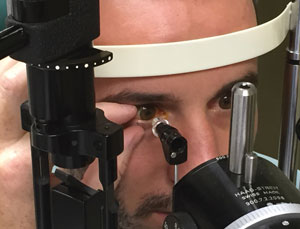 |
Large IOP fluctuation may indicate a patient has normal-tension glaucoma. Photo: Natalie A. Townsend, OD. Click image to enlarge. |
Patients with normal-tension glaucoma (NTG) can be difficult to identify because they often don’t exhibit the high pressures seen with other types of glaucoma. A recent study suggested that intraocular pressure (IOP) fluctuations may help clinicians diagnose NTG. The independent study used a contact lens sensor (Triggerfish) to monitor patients’ IOP over a 24-hour period and found that pressure fluctuations occur significantly more often in eyes with NTG and non-glaucomatous eyes.
The study included 18 non-glaucoma subjects and 26 subjects with NTG. Subjects without glaucoma had a mean IOP of 12.3mm Hg, and subjects with NTG had a mean IOP of 12.5mm Hg. The researchers examined all subjects for maximum IOP value, standard deviation, IOP fluctuation range, and two measures of amplitude. They reported that all indicators were significantly higher in the NTG group.
“The best factor to distinguish the non-glaucoma subjects and NTG patients was the IOP fluctuation range,” they wrote in their paper for Journal of Glaucoma. “Greater IOP fluctuation may be a contributory factor in NTG independent of the IOP. We previously reported that the larger IOP fluctuation with a contact lens sensor, the faster the progression of visual field [loss].”
Tojo N, Hayashi A. Twenty four hour intraocular pressure indicators distinguish normal-tension glaucoma from healthy eyes measured with a contact lens sensor. J Glaucoma. June 29, 2022. [Epub ahead of print]. |

